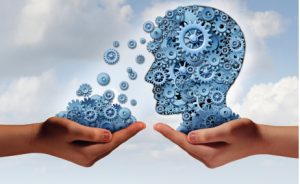 HOW YOUNG IS YOUNG AND HOW OLD IS OLD?
HOW YOUNG IS YOUNG AND HOW OLD IS OLD?
Have you heard the saying “You can’t teach an old dog new tricks? This saying comes from the knowledge that the brain learns information differently throughout our life cycle and that there are “windows” of opportunity for learning certain things such as language acquisition.
Through research we also know that the brain changes throughout our life cycle. However, when it comes to being mentally healthy, the brain can learn, change, and improve, regardless of age.
Mental health is a broad term that encompasses our emotional, psychological, and social well-being. It can also have a profound impact on our physical well-being and daily functioning. Mental health affects how we think, feel and act as we cope with life and is important at every stage of life, from childhood and adolescence through adulthood.
At The Brain and Wellness Center in Boca Raton, our mission is to help bring education and optimal mental health to the clients that we serve. We enjoy utilizing all our skills to enhance the quality of life and bring hope towards a better future for our clients.
HOW CAN I BE MENTALLY HEALTHY?
Being mentally healthy can be achieved in different ways for different people. At our clinic, we don’t take a one-size-fits-all attitude. Instead, we customize each session to fit the individual and base this on their needs, symptoms, and individual differences. We offer several different services in-house and will not hesitate to refer out for services we don’t offer if needed. Through Neurofeedback, EMDR, and counseling, optimal mental health is within reach.
NEUROFEEDBACK
Neurofeedback, also known as EEG biofeedback, has been studied and practiced since the late 60’s. It is exercise for your brain; allowing you to see the frequencies produced by different parts of your brain in real-time and then through auditory feedback, teaches the brain to better regulate itself. Neurofeedback can be used to help detect, increase, and/or inhibit activity in the brain safely and without medication. It can help restore a wider “range of motion” in brain states, much like physical therapy does for the body.
While the client sits comfortably watching a movie or pictures appear on the screen (a calm and focused state), the EEG equipment measures the frequency or speed at which electrical activity moves in the areas where electrodes have been placed. This information is sent to the therapist’s computer. The therapist is then able to determine what frequencies are out of balance. For example, when the EEG shows that you are making too many “slow” or “sleepy” waves (delta/theta) or too many “fast” waves (high beta), the therapist adjusts a reward band to encourage more balanced activity. This encouragement or “reward” happens through an auditory reinforcement of “beeps” and sometimes through visual reinforcement of changes on the screen. Neurofeedback is an effective treatment for all ages. From infants to geriatric, everyone benefits from improving brain patterns.
WHAT TYPES OF CONDITIONS DOES NEUROFEEDBACK HELP?
Symptoms of these conditions, among others, can improve through neurofeedback training:
Anxiety
Sleep disorders
Depression
ADD/ADHD
Sensory processing disorder
Bipolar Disorder
Seizure Disorders
Auditory/visual processing
Chronic pain/Fibromyalgia
Migraines/headaches
Traumatic brain injuries
Stroke
Cognitive decline
Peak performance
Oppositional defiant disorder
Rages/mood swings
Attention/focus/concentration
Reactive attachment disorder
Autism/Asperger’s
Learning disabilities
Obsessive Compulsive Disorder
Long and Short-term Covid and Vaccine Symptoms
WHAT IS A QEEG (QUANTITATIVE EEG) OR BRAIN MAP AND DO I NEED ONE?
The QEEG is a quantitative EEG. It’s also called a brain map and does just that… it gives us a map of what is going on with the entire brain at one time. We attach electrodes to the whole head, 19 spots, and then record the brain waves with eyes open for 5 minutes and with eyes closed for 10 minutes. The QEEG is not a medical EEG and cannot replace it. The QEEG is unable to detect seizures or pathology in the brain that is diagnosed by a Neurologist. However, the QEEG is an excellent tool for implementing treatment. With a QEEG the brain activity is not only compared spot by spot over the entire head, but we can also look at connections, symmetry, and how different parts are communicating. We don’t always need this data to make improvements in symptoms, but we do recommend it in certain situations. A QEEG can also be helpful information when diagnosing and/or trying to decide the best medication/supplement recommendations.
EMDR
EMDR or Eye Movement Desensitization and Reprocessing, focuses on the memories we have that were stored incorrectly and therefore continue to disturb us, even if we’ve reasoned them out. These memories get stored in the emotional part of our brain, so accessing them leaves us feeling as if we are still experiencing them, and all the same hurt comes back. EMDR allows the brain to tap into these feeling memories and conjoin them with more logical reasoning so that we can heal them. We don’t lose the memories, but we lose the emotional grip they have on us. EMDR is an effective treatment for all ages. Even small children can get “stuck” in trauma experienced early in life that the brain stores and they are unable to connect.
What are the Symptoms that can be helped by EMDR?
High anxiety and lack of motivation
Depression
Memories of a traumatic experience
Fear of being alone
Unrealistic feelings of guilt and shame
PTSD
Difficulty in trusting others
Relationship problems
IS EMDR NEW?
Since the initial medical study in 1989 positive therapeutic results with EMDR have been reported with the following populations:
People who have witnessed or been a victim to a disaster.
Clients suffering from PTSD (post-traumatic stress disorder)
Suffers of panic disorders and anxiety attacks
Suffers of phobias
Chemically dependent clients
Persons exposed to excess loss
First Responders
Accident or burn victims
EMDR is similar to that of REM sleep, when our eyes move as we sleep, our brain is able to process the information we have collected through the day. In an EMDR session, your eyes are guided with hand movements or tappers, back and forth at a calming pace. While the movement is happening, you may experience different memories, thoughts about the memories, feelings may come up and they may sometimes be intense. Through this process, you will be guided and supported. By the end of the process, your memory, and thoughts about the memory will be different. It won’t hold the same feelings for you anymore, and you may see yourself, and indeed your life, in a new way.
EMDR is a powerful with children as well, helping them move past fears and behaviors triggered by past events. It is done through play and can help move children through tough times with less stigmatizing affects. The children continue to work through therapy in play, with the EMDR allowing the brain to work out their feelings much faster.
COUNSELING
There is no “right or wrong” way to benefit from counseling. Rather, it’s all about the “fit” and needs of our clients. At The Brain and Wellness Center we partner with different therapists in order to present options and techniques of counseling to fit your needs. Different counseling styles and approaches for individual clients of all ages, couples, and families; make us a unique and inviting place to heal and grow.
HOW DO I GET STARTED?
Getting started is easy, just contact us. Through a FREE, scheduled, telephone consultation; the Brain and Wellness Center staff will answer your questions, help you get scheduled and can help you determine what services are best for you. Text, call, or email us today!
Brain and Wellness Center, 7301 W. Palmetto Park Rd., Suite 102A, Boca Raton, FL 33433. (561) 206-2706, e-mail us at info@bocabraincenter.com, or text us at (561) 206-2706 or visit our website at www.BocaBrainCenter.com.
 South Florida Health and Wellness Magazine Health and Wellness Articles
South Florida Health and Wellness Magazine Health and Wellness Articles




